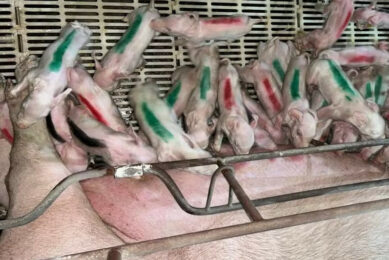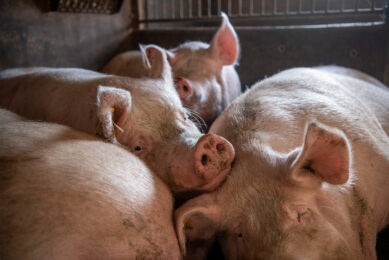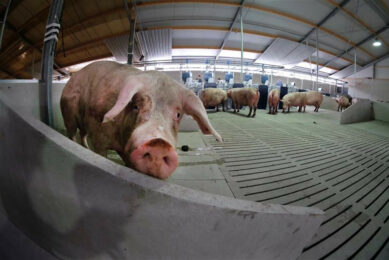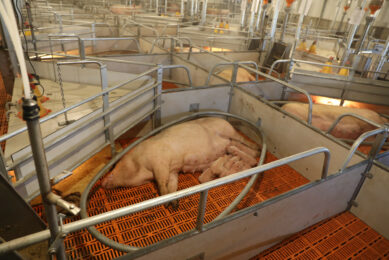How dietary fibre can tackle heat stress in sows

Heat stress is not only of interest for swine producers in countries with tropical or sub-tropical areas. Even in temperate latitudes, at least for a few weeks per year, sub-optimal climatic conditions occur. How can sows be better prepared for the heat?
When talking about heat stress, it is important to realise that it is not only the temperature that affects humans or animals; it is a function of ambient temperature and relative humidity. Figure 1 demonstrates that the risk of pigs suffering from heat stress rises even at a moderate temperature of 24°C when the relative humidity is 75%. In 2017, researchers Matthew C. Lucy and Timothy J. Safranski of the University of Missouri, USA, gave a range of thermoneutral conditions for pigs in the temperature range of approximately 15–22°C with 60–70% relative humidity.
Exact values for the increased risk of suffering from heat stress are species-specific due to differences in biological functions between livestock animals. Sows have only limited ability to cool down their body temperature by evaporation due to the lack of sweat glands in swine skin and will increase respiratory frequency.
First obvious signs of heat stress
Nevertheless, the first obvious signs of heat stress are quite similar across different species of livestock animals – they change their behaviour to get rid of excessive body temperature, to cool down via an enlarged body surface and to avoid as many heat-producing activities as possible: heat-stressed sows reduce their locomotion and lie (usually stretched out) in the coolest area of their barn, they restrict their feed intake and at the same time they increase their water consumption.
Reduced feed intake will have severe consequences, visible in diminished body condition of sows as well as reduced fertility (prolonged inter-oestrus intervals), smaller litter sizes and reduced weight of newborn piglets. In addition to losses due to those performance reductions, the sow’s health is impaired. Farms’ rentability is further cut by increased medication costs to address the rise in inflammation as well as by increased mortality.
For 2003, the total economic loss through impaired prodution due to heat stress was estimated at up to US$ 2.4 billion across all livestock species, including losses of US$ 299–316 million for the US swine industry alone.

Physiological background of impaired performance
From the physiological perspective, heat stress affects the animal on various levels: a heat stress dependent reduction of the trans-epithelial electric resistance (TEER), which measures the integrity of the intestinal barrier, was not only shown by in vitro data for cell cultures, but also results in vivo in growing pigs. The weaker the intestinal barrier, the easier it is for pathogens to invade the organism, eliciting infections and provoking inflammatory processes as an immune response. The more energy a sow needs to allocate for immune responses, the less energy can be utilised for growth of foetuses. In addition, reduced sow performance can also be linked to morphological changes of the small intestine, as shown by a team led by Sarah C. Pearce at Iowa State University in 2015, who reported a tendency for smaller villus height and thus a diminished absorptive capacity in the gut of heat-stressed pigs.
Consequently, impaired nutrient uptake can reduce the production and impair the quality of a sow’s milk, which in turn will negatively affect piglet growth during lactation and their weaning weight.
Fibre for heat-stressed animals
With respect to a reduced feed intake and impaired nutrient absorption by heat-stressed sows, the status quo feeding strategy is to provide a high-energy concentrated feed dense in nutrients and keep the proportion of undigestible fibre as low as possible.
Paradoxically, the opposite strategy of including considerable amounts of fibre will be highly beneficial for the animals: the reason is that the usual strategy focuses on impaired nutrient absorption only, whereas the fibre strategy focuses on gut integrity and health and optimises the nutrient absorption as a corollary effect. However, the quality of the fibre source is important.
Recommendations for fibre supply under heat stress conditions consider the reduction of soluble fibre that results in excessive fermentation. Wheat bran, soybean hulls or sugar beet pulp contain high amounts of soluble fibre with additionally high proportions of fibre-bound protein that supports unfavourable protein fermentation in the large intestine. The supplementation of a concentrated fibre source, such as lignocellulose, can provide insoluble fibre.
Lignocellulose: Quality matters
Compared to basic lignocellulose products, which consist of 100% insoluble and non-fermentable fibres and mainly provide a physical effect in the gastrointestinal tract supporting passage rate, eubiotic lignocellulose represents a synergistic combination of both insoluble non-fermentable and insoluble fermentable dietary fibre. Non-fermentable parts have physical effects on peristalsis and minimising the incidence of constipation, which is highly relevant for a smooth farrowing process, and its fermentable parts selectively increase metabolites such as lactic acid and butyric acid. These limit pathogens and proteolytic bacteria and decrease production of ammonia. The fermentation metabolites provide continuously additional energy, avoiding glycaemic stress. These health-related effects are of high importance in supporting sows in periods of metabolic stress.
With respect to feed for heat-stressed animals, an intended fermentation process in the hindgut seems to be, at a first glance, another contradiction: fermentation is a highly exothermic biologic process, meaning that the degradation of the fermentable fibre content produces additional heat, which certainly is counterproductive in avoiding thermal stressors. Nevertheless, the negative impact of the fermentation-related heat production is negligible compared to the positive effects of lignocellulose on gut functions, such as improved gut motility, increased villus height, optimised gut integrity and additional energy supply out of hindgut fermentation – this phenomenon is similar to another very well-known counterstrategy against heat stress: panting. The heat produced by muscle contractions of an increased respiratory rate is lower than the amount of dissipated heat. Proof of a positive net effect due to a partly fermentable lignocellulose supplementation in heat-stressed sows is given below.
Effects of eubiotic lignocellulose in practice
In a commercial sow farm in South Korea, the effect of such a eubiotic lignocellulose (OptiCell; Agromed Austria) was tested in 500 sows under field conditions. Parameters such as number of born piglets, pre-weaning mortality and number of piglets with underweight or abnormalities were compared over a four-month period without followed by four months with inclusion of eubiotic lignocellulose at a dosage of 1.0% from two weeks before farrowing until weaning. The inclusion of eubiotic lignocellulose started at the beginning of May, simultaneously with the onset of a heat wave.
Table 1 indicates the over-compensatory effects of eubiotic lignocellulose: despite heat stress, performance parameters were improved compared to the thermo-neutral period due to the inclusion of eubiotic lignocellulose. This is also illustrated in Figures 2 and 3 showing the monthly proportions of underweight piglets and pre-weaning mortality across the study period. Both parameters are clearly improved with eubiotic lignocellulose supplementation despite the onset of the heat stress period.


With respect to the gilts, which are the future of the farm, it may be concluded that any condition that limits oxidative stress during a heat stress period helps the gilts improve future gestation with a decrease of ovarian heterogeneity.
Eubiotic lignocellulose may kill two birds with one stone: it delivers an adequate fibre supply to support the microbiota for beneficial fermentation and avoids excessive soluble fibre.
References available on request.










